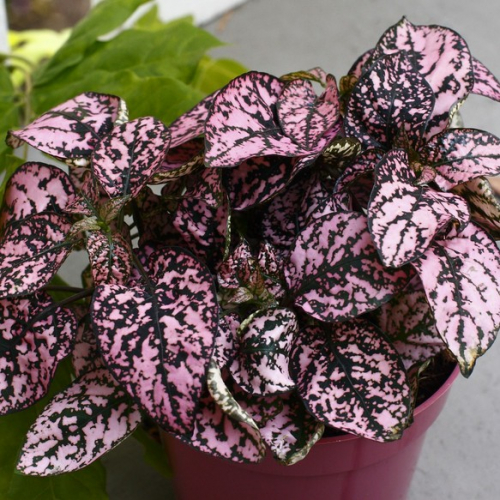Indoor plants Hypoestes

Description
Special Features of Hypoestes
Hypoestes is an interesting perennial plant in the acanthus family Acanthaceae and it is quite popular among indoor plant enthusiasts. In the wild, it grows in South Africa, Southeast Asia, and Madagascar. The foliage is the main reason to grow this plant. Hypoestes has exceptionally ornamental leaves. Their colours and intricate patterns vary from cultivar to cultivar. White, pink, red streaks, spots, or specks on the leaves in one variety become basic colours in another variety. Hypoestes matches well with pink and white Camellias and Spurflower (Plectranthus argentatus).
Hypoestes is not especially challenging to grow and can be recommended for beginners. You can easily find and buy Hypoestes in any flower shop or online catalogue. The most popular and widespread species are Polkadot Plant (Hypoestes phyllostachya Baker) and Freckle Face (Hypoestes sanguinolenta Hook). Each variety has specific characteristics and features but when you choose a variety, just rely on your personal preferences. Do not be surprised if some time after purchase you will find new or changed features in your plant. That is because Hypoestes is very responsive to fertilizers and commercial growers usually have their unique recipes to achieve vivid colours, showiness, and originality.
To ensure that your plant thrives and delights you with a healthy, well-groomed look, you should know and follow some basic care rules.
The Secrets to Successfully Growing Hypoestes
Hypoestes needs light. Do not leave the plant in direct sunlight for too long. If you place the plant in the southern exposure window, it will need protection in the summer. It is better to place the plant in the east- or west-facing window. In the winter, Hypoestes may require supplemental lighting. You will understand it immediately, since the lack of light causes original colourful patterns on the leaves to slowly but surely disappear.
Hypoestes loves warmth. In the summer, the best temperatures are 23-25 ° C (not less than 17-18 ° C). In the winter, the temperatures 17-18 °C are quite acceptable for the plant. Failure to meet the temperature range is dangerous. Hypoestes may wilt and eventually die.
Allow the soil to dry out before the next watering. This is particularly important if the plant is kept in cool environment. Water after the surface of the soil in the pot has dried off. Use pots with drip holes or slits to ensure good drainage. Humidity in the room should be kept high throughout the year. The plant will benefit if you mist the foliage with warm water free from contaminants.
For feeding your plant, you can use organic, nitrogen, or compound fertilizers. The foliage will be brighter if you use potassium-containing fertilizer.
To keep the plant in a more attractive form, regularly pinch out tips. This helps to encourage bushiness but prevents Hypoestes from flowering. It should be also noted that the plants that ceased blossoming quickly grow old and lose their decorative qualities.
Once a year, repot Hypoestes into a larger pot with a drip hole. The soil must be lightweight and fertile. You can prepare the potting medium be mixing equal parts of loam, peat, sand, and compost.
Hypoestes is propagated quite easily from seed or by cuttings.
In the summer, bring the plant outdoors from time to time.
Potential Problems
Without good air circulation in the room, your plant becomes an easy prey to spider mites.
Waterlogged soil can cause root rot. The first signs of danger are yellowing and wilting of leaves. Underwatering causes drying of the root system; this, in turn, results in leaf dying and drop.
Shrivelling of the leaves indicates the lack of light and too dry air. Identify possible causes and address the issue immediately. The sooner you do it, the more chances your plant has to survive.







 334
334








